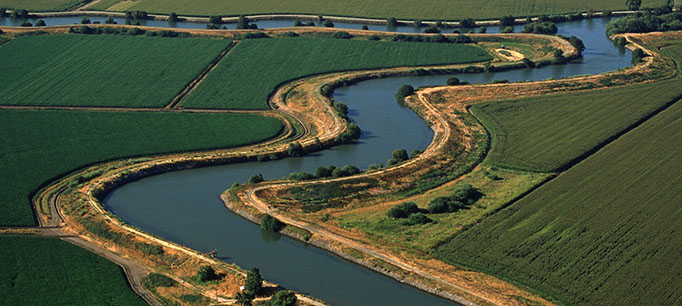The Sacramento–San Joaquin Delta is one of the West’s most important estuaries, and a critically important water source for millions of Californians. But decades of water exports and human alterations have transformed this aquatic ecosystem, and a few dozen of its native species have dwindled to the point of extinction. We interviewed Phil Isenberg, vice chair of the Delta Stewardship Council and a member of PPIC’s board of directors, about the state of the Delta.
PPIC: How is the Delta faring these days?
 Phil Isenberg: From an environmental perspective there’s not a lot of good news. The Delta is a severely damaged environmental site of great importance, and the damage has continued for more than 100 years. Very little restoration activity has taken place compared to the vast development of water supply infrastructure that has gone on in the past century. More housing is being built in flood-threatened areas, and urban growth continues on the boundaries. Some areas like Stockton are rapidly encroaching on agricultural and environmentally sensitive areas in Delta. The state’s Delta tunnel proposal has a greatly reduced environmental restoration plan—only about 30,000 acres of land will be put in protected status or restored for environmental purposes. It’s not insignificant, but certainly not as positive as the 150,000 acres which was part of the Bay Delta Conservation Plan.
Phil Isenberg: From an environmental perspective there’s not a lot of good news. The Delta is a severely damaged environmental site of great importance, and the damage has continued for more than 100 years. Very little restoration activity has taken place compared to the vast development of water supply infrastructure that has gone on in the past century. More housing is being built in flood-threatened areas, and urban growth continues on the boundaries. Some areas like Stockton are rapidly encroaching on agricultural and environmentally sensitive areas in Delta. The state’s Delta tunnel proposal has a greatly reduced environmental restoration plan—only about 30,000 acres of land will be put in protected status or restored for environmental purposes. It’s not insignificant, but certainly not as positive as the 150,000 acres which was part of the Bay Delta Conservation Plan.
PPIC: What is the role of the Delta Stewardship Council in managing this important resource?
PI: Our mandate is to achieve two equally important goals: to provide a more reliable water supply for California, and to protect, restore, and enhance the Delta ecosystem. It’s the latest legislative attempt to create a legally enforceable governance and management plan for the Delta. The Delta Plan was adopted in 2013; within 30 days we were sued by 27 plaintiffs, ranging from agricultural interests, state and federal water contractors, the city of Stockton, and several environmental groups. Interestingly, no state agencies or counties have sued. Their legal argument seems to be either we went too far or didn’t go far enough—which suggests to me that we may have struck the right balance.
PPIC: What does the latest science tell us about the Delta’s condition?
PI: Besides being severely damaged by human actions over centuries, the Delta has also been damaged by the drought and by the diversion of water for human purposes during drought. Scientists are skeptical about the ability of government or society in general to be able to rapidly improve the environmental condition of the Delta. We have altered the ecosystem in too many ways. We’ve channelized its waters, put in more than a thousand miles of levees, allowed people to move into the floodplain, brought in invasive nonnative species, and allowed pollutants to flow in from industry and agriculture. The best science we’ve received over the years is that the Delta’s environmental troubles can be managed better, but we will not likely be able to save all species in face of these threats. The political process demands immediate action, but science tells us that it will take decades to improve a Delta damaged over the past 160 years. A big part of any real solution is to involve independent scientists in decision-making and then follow their advice.
PPIC: What’s the most difficult tradeoff we’re facing in the Delta?
PI: The biggest problem is the conflict between illusion and reality. Basically, the water supply in California has not expanded since we began keeping track in the late 1880s. Worse, the water supply remains highly volatile. As our society has grown, demands for water have increased; our demands now exceed available water in many years. People have unrealistic expectations that ignore the limits of our supply. Although it is state policy to reduce human reliance on the Delta—and to compensate for that with heavy investments in water conservation, recycling, and the like—a lot of folks want more.
PPIC: What’s your biggest hope or aspiration for the Delta’s future?
PI: The Delta is constantly changing; we can’t freeze it in time. The Delta that existed before extensive human changes cannot be recovered. California hasn’t always done the right thing regarding water, but over time we get it right more often than not. So I hold out a reasonable level of hope for an improved Delta in the future. A successful Delta future for me is one that stops urbanization and protects its environment and the agriculture that remains. Will it work? Ask me in 100 years.
Learn more:
- Browse the PPIC Water Policy Center’s resource page on the Delta
- Fact sheet: California’s Water: The Sacramento-San Joaquin Delta
- Read Isenberg’s favorite article about the Delta: “The Once and Future Delta: Mending the Broken Heart of California,” Bay Nature magazine, April 1, 2010


